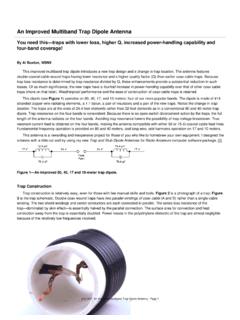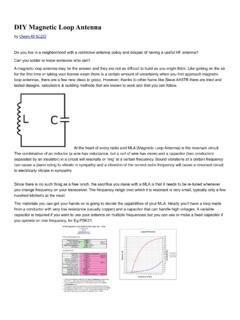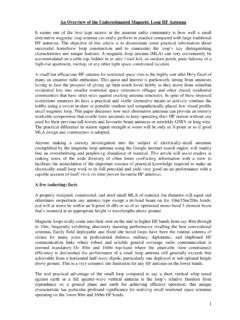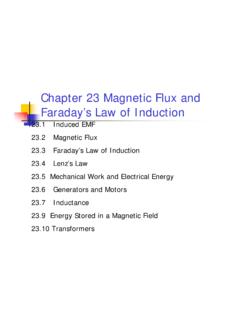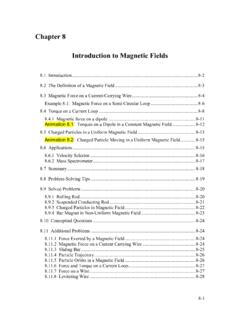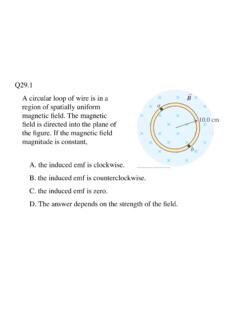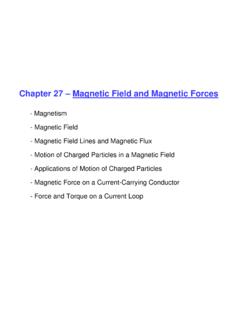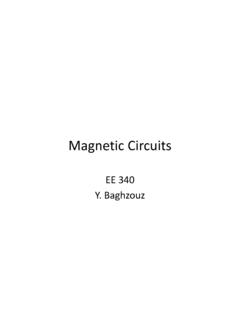Transcription of W2BRI - An Easy Guide to How to Build Your Own Magnetic …
1 W2 BRI - An Easy Guide to How to Build Your Own Magnetic LoopPage 1 of 19An Easy Guide to How to Build Your Own Magnetic LoopFor many people without building experience following instructions on how to make something is not always that easy. Many manuals and how-to sites can be hard to follow, not well explained, and simply assume too much. I hope to take you step by step through the process of building a Magnetic loop out of copper pipe. I will list all the parts you need, where to get them, and how to put them together. If I can do it, I am pretty sure you'll be able to do it too! Just try not to get intimidated when I use words like torch or solder. I will explain that as well as I So read through the article. Re-read it, and then go out and buy your parts and tools. And if you follow the steps, you should have yourself a nice loop antenna that works well and fits at almost any QTH. Let's Build a loop for 20 meters that exhibits around 65% efficiency.
2 We'll make it out of .5 inch copper pipe and each side will be feet long. This loop is nice because is it so light and easy to place pretty much anywhere. Yes, I most certainly could and will give you other designs that are more efficient, but I want to start with something easy to make and use. Once you get the hang of it, you will be able to move on to more challenging projects. We'll do it easy and use a coaxial stub as a capacitor for each band and I'll show you how to change bands when you so desire. Alternative Design: I would also recommend a loop that is 30 inches on each side and made from one inch diameter pipe. It won't be as efficient as the foot version, but it will be close to it in performance. What I like about the 30 inch version is it fits in car trunks very easily. It will also store well in a suitcase. It is more portable than the foot version and more sturdy. DISCLAIMER: I take no responsibility if you end up getting hurt or damaged in the process of building this loop.
3 Sorry guys, but considering the litigious nature of people these days I have to say this clearly. You're on your own with this one. You hurt yourself, or damage your own property, it's your problem. If you have any doubt about your ability to Build this loop, or follow these instructions without getting hurt, DON'T Build IT. Even if you think you can Build this loop and not get hurt and do get hurt, your doing it at your own risk! This information is purely for your intellectual pleasure and if you want to go ahead and Build it, that's your choice and your responsibility. Having said that. let's get down to details. W2 BRI - An Easy Guide to How to Build Your Own Magnetic LoopPage 2 of 19 Parts You'll Need:Quantity Item 490 Degree Elbows4 foot pieces of copper4 Copper end caps4 Small Radiator clamps20 feetRG8U or RG-213 Coax10 feetThin copper pipe/thick copper wireW2 BRI - An Easy Guide to How to Build Your Own Magnetic LoopPage 3 of 19 Tools You'll Need: 1.
4 Torch for soldering plumbing2. Silver Solder 3. Flux and brush to spread the flux. 4. Screwdriver 5. Razor blade 6. Electrical tape 7. Copper pipe sanding brush 8. Copper pipe sanding material 9. A good pair of leather gloves (highly recommended) 10. MFJ or other make Antenna Analyzer How to Solder Copper Pipe Let me start out by saying I am not a plumber and am sort of self taught in the area of copper soldering. If you have issue with the way I solder, that's OK, send me an email and let me know. For now I'm going to put down what I know and what has worked for me. 1. Preparing the Joint : Take 1 piece of foot long copper in hand. Take your plumber's sanding strip or fine sand paper and sand down the final inch of the pipe that you intend to put into the 90 degree elbow. If you need to check the measurement, do so by placing the copper in the 90 degree elbow, it shouldn't get stuck and check the length.
5 Now after you have sanded the area, this should take 10 seconds, put the copper pipe down. Now take the 90 degree elbow and use your copper sanding brush to sand the inside of the 90 degree elbow area that will eventually house the end of the foot peice of copper. This should also be done in about 10 seconds. Note: if you are working with .5 inch pipe, buy a .5 inch brush -- if you are working with 1 inch pipe, buy a one inch brush. OK. So the end of your copper pipe is sanded, and the inside of the 90 degree elbow is sanded. Take your flux compound and a small brush, and brush on flux to the outside the area of the copper pipe that you have sanded down already. Try to get a nice even amount around the outside of the sanded area, not too thin. Now place the copper pipe end with the flux into the 90 degree elbow. You are ready to solder your first - An Easy Guide to How to Build Your Own Magnetic LoopPage 4 of 192.
6 Soldering the Joint: Soldering is about using indirect heat, not direct heat. So when you turn on your torch and apply heat to the pipe, apply heat slightly off the center of where you intend to put your solder (you will apply your solder to the crease where the 90 degree elbow ends and meets your copper pipe). Your goal is to heat up the pipe to such a degree (in a specific place) that when you touch your solder to the intended target, the solder flows freely and melts around the joint crease. So step 1, you should have your copper pipe fluxed and inserted in the 90 degree elbow. Step 2, place your pipe in such a way where it won't move while your soldering it and yet you can still apply heat to the pipe and not set anything on fire (including yourself). I like to wear leather gloves too. Now, turn on your torch and apply heat to the bottom of the crease moving it side to side or up and down slowly.
7 You might notice beads of flux forming and dropping to the floor (this is called "sweating the pipe). I like to focus the heat on the bottom of the joint, becuase I touch the solder to the top of the joint occasionally to see if it will flow. This assures that the entire joint is hot enough so the solder will flow nicely around the entire joint crease. If you apply heat to the top only, and apply the solder to the top of the joint, it may be that the bottom of the joint isn't hot enough and you only get a partial solder around the crease. Now whenever you test to see if the solder will flow move the flame of the torch away from the pipe .. remember, the pipe should be hot enough for the solder to flow in that spot without any flame. You may have to leave the flame on the pipe for about 30 seconds to get it hot enough with some pipe sizes. It depends on the pipe and the torch, you'll have to see for yourself.
8 I use Mapgas torches which burn hotter, so I don't have to wait as long for the pipe to get hot enough and the solder to flow. So the solder is now flowing and you find that you have a completed solder joint. 3. Walking Away for a While: Shut off the torch and walk away. That's right, that entire pipe and joint are so hot that if you think your going to anything to it for a while your mistaken. It will take about 15-20 minutes for that pipe to cool enough to work on it. And I wouldn't recommend handling the pipe at all, I have burnt myself a couple times trying. Also, you do not want to use methods like dunking the joint in a bucket of water to cool it down, because my metal working friends tell me this softens the copper (it loses it form more easily) and can also crystalize the solder and make for bad solder joints. I have no idea of this is true, but I'll take their advice. If do want to cool the pipe in water anyway because your impatient, wear gloves and watch what your doing.
9 The pipe will cool down, and you can continue working on the next joint, but be careful: you may have cooled one part of the pipe, but part of it still may be hot! W2 BRI - An Easy Guide to How to Build Your Own Magnetic LoopPage 5 of 194. Completing the Other Joints: If you feel like you're getting the hang of the soldering business, you may discover that you can prepare each copper pipe end and 90 degree elbow, and then solder both sides of the elbow at once. That's what I do. I sand, flux, and then insert two copper pipes into an elbow, and then heat one joint side and solder, and while the elbow is still hot, heat a little more and then solder the other side. This saves a lot of time. Also, make sure all the pipes are straight when you solder them. You want a symmetrical square in the end, not a crooked square. So take your time, and if need be, solder joints slowly and in alignment, so you won't only be happy with the way the loop performs, but the way it looks too!
10 By the end of this step, you should have a completely enclosed and soldered copper - An Easy Guide to How to Build Your Own Magnetic LoopPage 6 of 195. The Final Cut and Solder: I almost need to cut the loop to prepare the area where the capacitor is affixed. OK. Take your pipe cutter in hand and a ruler. Measure out the length of one of the sides of your square. It doesn't matter which side it is, they should all be identical. Slowly cut a 2 inch peice of copper out of the middle of one of these sides. This should be fairly easy. Once you have the gap in place, go ahead and solder on the two end caps we bought. Solder on each cap at a time, don't try to do them at once, because the the pressure change from the solder process will make one of them pop off! It happend to me once. All right, we have the basic loop completed. We are almost to stepW2 BRI - An Easy Guide to How to Build Your Own Magnetic LoopPage 7 of 19 Creating A Coaxial Stub: 1.


